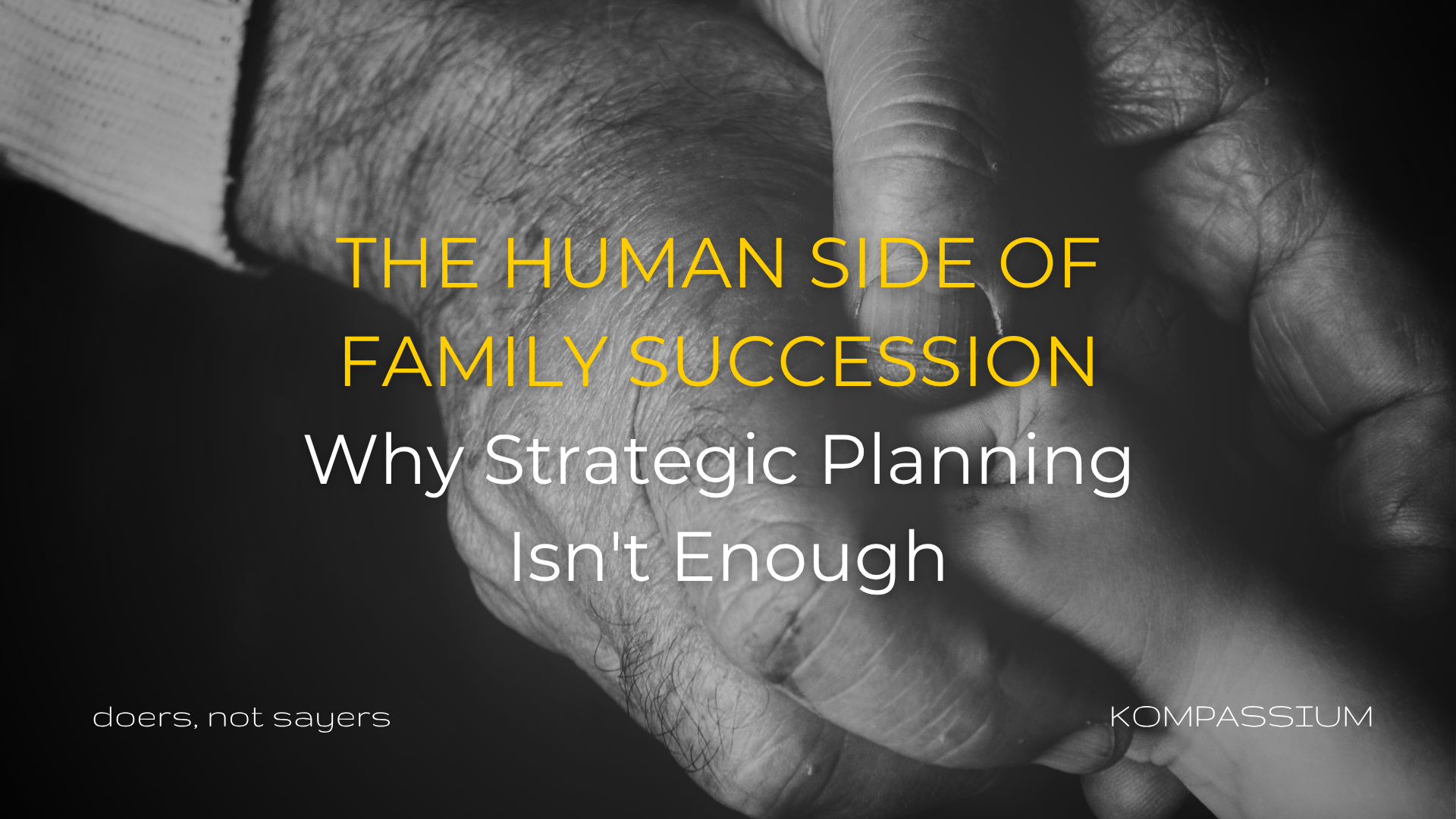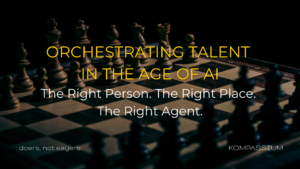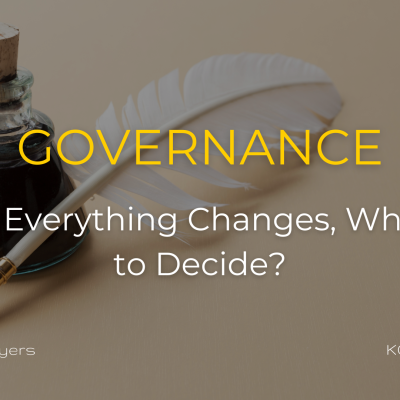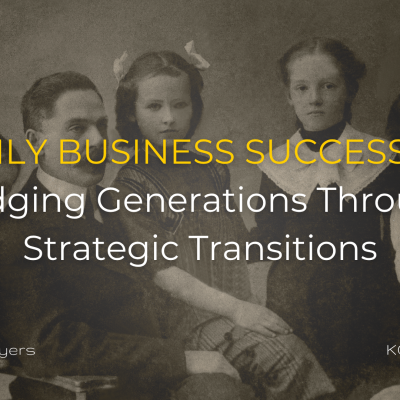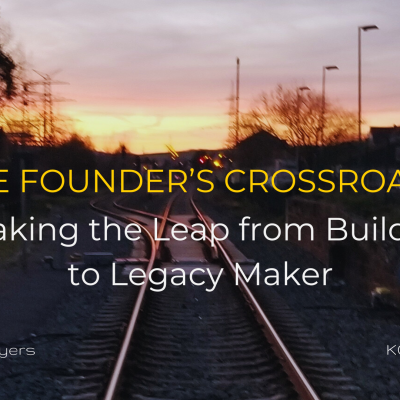by Silvia Micelli and Marcos R Leal, KOMPASSIUM Partners
In our recent article, “Family Business Succession: Bridging Generations Through Strategic Transitions,” we explored the structural foundations necessary for successful family business succession—the governance frameworks, strategic clarity, capability development, and communication systems that enable multi-generational continuity.
Yet, as we work with family businesses navigating these transitions, we consistently observe a critical gap: even the most meticulously crafted succession plans can fail if they don’t address the profound human and emotional dimensions of letting go and assuming leadership.
This isn’t about adding a “soft skills” component to an otherwise technical process. It’s about recognizing that family business succession is fundamentally a human transformation that involves business structures, not the other way around.
While our previous article established the “what” and “how” of succession planning, this perspective explores the equally crucial “who”—the people at the heart of the transition and the inner work required to make succession not just successful, but transformational.
The Missing Piece: Why Founders Sabotage Their Own Succession Plans
Having established the structural requirements for succession in our previous analysis, we now turn to what often determines whether those well-laid plans actually work: the psychological and emotional readiness of the people involved.
Even with robust governance structures, precise role definitions, and systematic capability development programs in place, we consistently see succession plans stall or fail because of unaddressed human factors. The most common culprit? The founders themselves.
We observe that one of the most significant obstacles to succession is the often-unconscious resistance of the founders themselves in “passing the baton.” After years dedicated to building and growing the company, the founder’s identity merges with that of the business. The idea of disengaging can evoke feelings of loss of purpose, control, or relevance, transforming into a genuine “unconscious saboteur” of the process. This difficulty in letting go can manifest in hesitation to delegate, micromanagement, or a lack of genuine investment in developing and empowering potential successors.
Another critical point is the potential disconnect between the company’s essential identity (its founding values, mission, and purpose) and the likely successor. It’s not enough for the successor to possess technical competencies or market experience. For the transition to be lasting and authentic, there must be a deep alignment between the successor and their values, passions, and what the company represents. Without this resonance of purpose, leadership can lack meaning, resulting in lower engagement, misaligned decisions, and distancing from the original legacy.
These human challenges, if not approached with attention and intentionality, can generate stress, overload, and even risk burnout for all parties involved, in addition to creating barriers to effective communication and hindering the development of trust relationships within the family and organization.
Beyond Strategic Frameworks: The Inner Work of Succession
Where our previous article focused on building external systems for succession, this perspective addresses the equally critical internal transformation required. The hybrid approach we advocate combines the strategic planning frameworks we’ve already outlined with deep investment in human development and consciousness.
This isn’t an either/or proposition—it’s recognizing that sustainable succession requires both external structure and internal readiness. You can have perfect governance documents and capability development programs, but without effective implementation, they will be ineffective. Still, if the founder can’t emotionally let go or if the successor isn’t authentically connected to the company’s purpose, the transition will struggle regardless of how well-designed the frameworks are.
The Human Development Dimension: Complementing Strategic Planning
Building on the four pillars we established in our previous article—strategic clarity, governance excellence, capability development, and communication mastery—we now explore the human development work that brings these frameworks to life:
The Founder’s Journey: From Builder to Legacy Enabler
While our strategic frameworks address the “what” and “how” of founder transition, the human dimension addresses a more complete personal transformation:
- Conscious Detachment Work: Moving beyond intellectual understanding of succession, there needs to be emotional readiness for transition
- Identity Reframing: Helping founders discover purpose and meaning beyond day-to-day operational control
- Legacy Visioning: Shifting focus from “my company” to “our family’s multi-generational enterprise”
The Successor’s Authentic Leadership Development
Beyond the capability development programs outlined in our structural approach, successors need deeper preparation:
- Purpose Alignment: Ensuring an authentic connection between personal values and the company mission
- Authority Building: Developing legitimate leadership presence rather than an inherited position
- Emotional Resilience: Preparing for the psychological challenges of leading in the founder’s shadow
Family System Transformation
Complementing our communication mastery pillar, this involves deeper relationship and consciousness work:
- Generational Bridge-Building: Creating genuine understanding and respect between different perspectives
- Conflict Transformation: Moving beyond conflict resolution to conflict prevention through deeper understanding
- Shared Meaning Creation: Developing family narratives that honor the past while inspiring the future
Integrating Human Development with Strategic Planning
The implementation process we outlined in our previous article—foundation building, preparation and planning, transition execution, and post-succession adjustment—gains significantly more power when enhanced with parallel human development work:
During Foundation Building (10-15 years out):
- Founder Self-Awareness Work: Beginning the psychological preparation for eventual transition
- Family Values Clarification: Moving beyond stated values to lived values that guide decision-making
- Next-Generation Purpose Exploration: Helping potential successors discover their authentic connection to the business
During Preparation and Planning (5-10 years out):
- Intensive Succession Readiness Work: Accelerated human development for both founder and successors
- Family Relationship Strengthening: Addressing long-standing relationship patterns that could undermine succession
- Leadership Presence Development: Building the successor’s authentic authority and influence
During Transition Execution (1-3 years):
- Transition Support Coaching: Ongoing emotional and psychological support during the actual handover
- Role Redefinition Work: Helping both parties navigate their changing relationship and responsibilities
- Family Communication Facilitation: Ensuring healthy dialogue during periods of uncertainty and change
During Post-Succession Adjustment (1-2 years):
- New Normal Integration: Supporting the establishment of new working relationships and family dynamics
- Legacy Celebration and Future Visioning: Honoring what’s been accomplished while inspiring continued growth
- Continuous Development: Ongoing leadership development for the successor and purposeful engagement for the founder
The Cost of Ignoring the Human Dimension
We’ve seen too many families with excellent strategic succession plans fail because they underestimated the human work required. Consider these common scenarios:
- The Prepared Successor Who Can’t Lead: Technically qualified next-generation members who struggle with authority because they never developed an authentic connection to the business purpose
- The Founder Who Won’t Let Go: Leaders who intellectually support succession but unconsciously undermine it through micromanagement and decision reversal
- The Family That Falls Apart: Relationships that deteriorate under succession pressure because underlying dynamics were never addressed
As we noted in our strategic framework, only 30% of family businesses survive to the second generation. While structural issues contribute to this statistic, human factors—such as unresolved founder attachment, successor authenticity gaps, and family relationship breakdowns—are often the decisive factors in failure.
Completing the Succession Equation
Our previous article established that successful family business succession requires strategic clarity, governance excellence, capability development, and communication mastery. This perspective adds the crucial fifth element: human development and consciousness work.
The most successful family businesses we work with understand that succession is both a strategic challenge and a human transformation. They invest in both external systems and internal development, recognizing that sustainable multi-generational success requires leaders who are not just technically capable but emotionally mature, purposefully connected, and relationally skilled.
This isn’t about making succession “softer”—it’s about making it stronger. The families that thrive across generations are those that recognize succession as an opportunity for profound leadership development, deeper family connection, and authentic legacy creation.
By integrating human development work with strategic planning, family businesses don’t just transfer ownership—they transform both the individuals involved and the enterprise itself, creating the foundation for multi-generational flourishing rather than mere survival.
Silvia Micelli is a Lead Advisor at KOMPASSIUM, and, Marcos Leal, its Managing Partner worldwide. KOMPASSIUM is a global network of experienced leaders committed to business transformation and sustainable growth. KOMPASSIUM bridges the gap between elite expertise and straightforward strategic execution, helping organizations navigate complexity, seize opportunities, and drive innovation.
